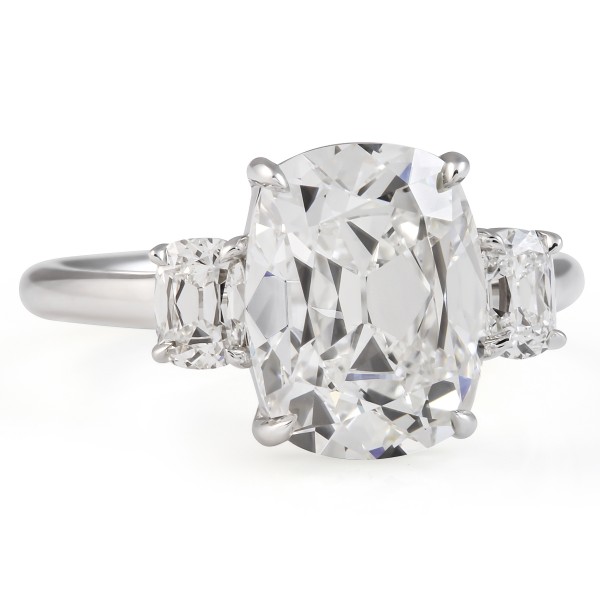Click here to get this article in PDF
The way a diamond is cut unlocks a whole new dimension of sparkle, fire, and personality. While the round brilliant will forever be the quintessential staple shape, a captivating array of unique cuts awaits discovery. Let’s dive into the fascinating world of unique diamond cuts.
The Unique Way Diamonds are Formed
Natural diamond formation process takes billions of years and starts with carbon atoms deep within the Earth’s mantle. Exposed to extreme heat and pressure, these tiny carbon atoms began to crystalize and eventually formed rough diamonds. They eventually make their way closer to Earth’s surface through volcanic eruptions where they can be mined and fashioned into polished diamonds.
A diamond’s chemistry is surprisingly basic; they are almost entirely carbon with most of their makeup being tiny carbon particles. Occasionally, trace elements such as nitrogen or boron fuse with a diamond’s crystalline structure during its formation drastically altering its color.
Understanding Shape vs. Cut
Diamonds, in their rough form, are simply chunks of carbon rock. It’s the cutting process that unlocks their true brilliance and fire, transforming them into the dazzling gemstones we admire. But before diving into the world of unique cuts, let’s clear up a common misconception: diamond shape and diamond cut are not the same thing.
Shape vs. Cut: The Two Faces of a Diamond
- Shape: This refers to the outline of the diamond when viewed from above, in other words, their face-up appearance. Gem shapes are characterized by their initial visual appearance. Shapes include ovals, pears, hearts, and rounds.
- Cut: Cut, in comparison, focuses on facets, polish, and symmetry. It refers to how light moves through the stone and governs things like scintillation, fire, and brilliance. Cut is the proportions of a stone and how that works with light. Some of the most popular cuts are radiants, cushions, and emerald cuts..
Types Of Unique Diamond Cuts
It’s hard to make a diamond look bad, after all it is a diamond. However, after decades of seeing the same diamond trends, it has been hard for new diamond cuts to find their place in the popular market for long. However, these unique diamond cuts have done quite well, some newer and some making a comeback.
Antique Cuts
Antique cuts are characterized by their chunky faceting and visible open culet. These cuts are as old as diamond cutting itself. While there are different types of antique cuts available, the most popular being the antique cushion cut (Old Mine Cut) and the Old Euro cut. Lauren B also carries some antique ovals, and antique marquise cuts.
Should you choose an antique cut, we recommend opting for a stone with color grade of J or above with a clarity of SI2 or above.


4.04 carat Antique Cushion Lab Diamond Three-Stone Ring


3 carat Old Euro Lab Diamond Pave Ring
Hybrid Cuts
Hybrid cuts look exactly like: a hybrid between two different cuts. The most common type of hybrid cut is the hybrid step-cut. Hybrid step-cuts are a cross between an emerald cut and a cushion cut; they combine the step-cut faceting of an emerald cut with the rounded corners and brilliance of a cushion cut.
Cushion cuts, famous for its intense sparkle, showcases numerous precisely angled facets that amplify a diamond’s fire. While the step cut emphasizes geometric shapes and clean lines, utilizing flat, parallel facets to produce a subtle brilliance and an intriguing “hall of mirrors” effect. Hybrid cuts merge elements from both cutting styles and integrate step-cut shapes with brilliant facets and the result is a brilliant and fascinating look. Lauren B also carries a selection of hybrid ovals and hybrid antiques.
Now it depends on the type of the hybrid cut, but we recommend using various colors and clarity grades. People who are color-sensitive should opt for higher color, but to the naked eye, J color and above will do just fine. For clarity, however, we do not recommend going below VS2.


2.83 carat Hybrid Step-Cut Lab Diamond Two-Tone Ring


3.26 carat Antique Hybrid Lab Invisible Gallery™ Ring
Hexagon Cut
A hexagon cut is a relatively new and unique diamond shape. It is a combination of emerald cut and marquise, boasting roughly the same shape as a marquise cut but with step-cut faceting. Similar to the hexagon cut is the Duchess cut, a brilliant cut version of the hexagon cut. Technically, this is a hybrid cut, but since it is so unique and popular, it deserves its own category.
Since hexagon cuts are step-cuts, we recommend opting for a color grade no lower than J and a clarity of VS2 and above.


3.54 Carat Step-Cut Hexagon Lab Diamond Three-Stone Ring
Heart Shapes
The Heart Shape is the most romantic brilliant cut diamond. Heart shaped diamonds are really a pear shape with a cleft at the top. They tend to be naturally heavy-set and must be cut with extreme accuracy to ensure maximum brilliance.
If you want something more traditional then look for length-to-width ratios between 1:0.9 and 1.1. Same with all other brilliant cuts, we tend to recommend J color and SI2 clarity as a minimum.


3.24 carat Heart Shape Lab Diamond Invisible Gallery™ Ring
You Know You Need a Unique Diamond Cut
Whether you’re looking for a traditional ring or a unique, center stone, Lauren B is here to help you find the perfect diamond that matches your style and makes you happy. Schedule an appointment with one of our design consultants to design your dream engagement ring! You can also check our Instagram or Pinterest for inspiration.
